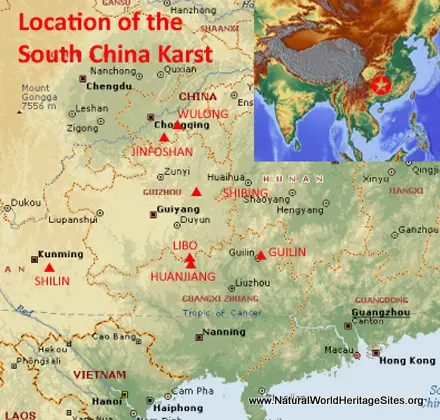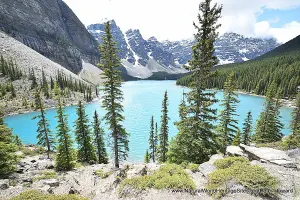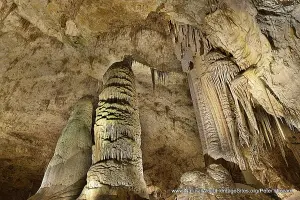EXPLORE CHINA’S SOUTH CHINA KARST with this slideshow, check the location map and get all the facts and information below.
For slideshow description see right or scroll down (mobile). Click to view slideshow
Location and Values: The South China Karst world heritage site is a serial site with seven widely separated clusters (a total of 12 component parts) spread over the provinces of Guizhou, Guangxi, Yunnan and Chongking. It contains the most significant types of karst landforms, including tower karst, pinnacle karst and cone karst formations, along with other spectacular characteristics such as natural bridges, gorges and large cave systems. It is representative of the huge karst area (some 500,000 km2) that covers much of southern China, Vietnam and the rest of Indochina.
Conservation Status and Threats. According to IUCN’s most recent Conservation Outlook Assessment (December 2020) the conservation status of the South China Karst is considered to be ‘good, with some concerns’. The exceptional values which are recognized by the site’s inscription on the World Heritage List are not seriously threatened, but a number of issues affecting conservation of the site are noteworthy, including:
- Atmospheric and groundwater pollution. Some components of the South China Karst are subject to varying degrees of atmospheric and groundwater pollution, including acid rain and agricultural runoff, which may (in the long term) affect the natural erosion processes that have produced the site’s spectacular karst formations.
- Increased tourism infrastructure development. There has been growing concern about the proliferation of tourism facilities as visitor numbers have increased, but recent measures to impose stricter controls and improve tour routes and visitor management has alleviated this threat. Some tourism service facilities have been relocated and various environmental control and ecological restoration projects initiated.
- Waste management. Some parts of the South China Karst are affected by inadequate disposal of solid waste from residents and tourism operations. This is a particular issue for heavily visited sites, such as the Shilin Stone Forest (which receives at least five million visitors annually).
- Subsistence cropping and livestock grazing. These activities are taking place within many of the component sites and may affect their aesthetic values and visitor experience, but are not likely to affect their spectacular geological formations.
- Natural disasters such as landslides, floods and droughts. Parts of the site experience earthquakes, landslides, accelerated soil erosion, flooding and drought. For example the region of Shilin Stone Forest is subject to frequent earthquakes, whilst Jinfoshan is vulnerable to rock collapses and landslides. These natural events contribute to the evolution of landscapes but may cause significant short term damage to the geological features that are recognized by the world heritage listing of the South China Karst. The intensity and frequency of natural events may increase as a result of climate change.
Links:
Google Earth
Official UNESCO Site Details
IUCN Conservation Outlook
UNEP-WCMC Site Description
Slideshow description
The photos in this slideshow are limited to just two of the ‘clusters’ of the South China Karst, starting with the cluster around Guilin. Here the gigantic cone karst formations which dominate the landscape in this area are shown as well as photos of rural life in this part of China. One particularly interesting aspect of traditional lifestyles in this area is night-time fishing of the rivers that flow through the area, using domesticated cormorants with a string ‘necklace’ that prevents them swallowing their catch. The second area of South China Karst featured in the slideshow is the Shilin Stone Forest near Kunming.
This page of the website is still under development and a more detailed description of the various aspects of the site will be included in due course – so please come back again soon!
Factfile
Website Category: Caves & Karst
Area: 971 km2
Inscribed: 2007 (Extension 2014)
Criteria:
- Outstanding natural beauty (vii);
- Geological features (viii);





